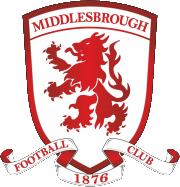
MIDDLESBROUGH F.C.
Founded: 1866
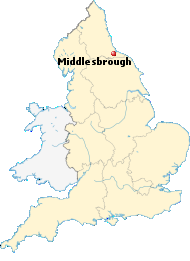
CLICK ON THE MAP TO
VIEW ENLARGED MAP
|
MIDDLESBROUGH F.C. (Football Club)
Included Info: Brief History, Club/Stadium Info, Team Jersey & Much More...
BRIEF HISTORY of MIDDLESBROUGH FOOTBALL CLUB
(reproduced from 'Wikipedia' pages)
Middlesbrough Football Club, also known as Boro, formed in 1876. They won the FA Amateur Cup in 1895 and again
in 1898. The club turned professional in 1889, but reverted to amateur status in 1892. They turned professional
permanently in 1899. After three seasons, they won promotion to the First Division, where they would remain for
the next 22 years. In 1903, the club moved to Ayresome Park, their home for the next 92 years. In 1903, the club
moved to Ayresome Park, their home for the next 92 years. Over the next few years, their form fluctuated greatly,
rising to sixth in 1907–08 before dropping to seventeenth two seasons later. The club rose to their highest league
finish to date, third, in 1913–14. The First World War soon intervened and football was suspended. Before league
football resumed, Middlesbrough won the Northern Victory League, but the team were unable to maintain their
previous form and finished the 1919–20 season in mid-table. They remained in the First Division for the next few
seasons, but were relegated in 1923–24 after finishing bottom, ten points adrift of their nearest rivals. Three
seasons later, they won the Division Two title. Their tenure back in the top flight lasted only one season, and
the club were relegated. They were promoted at the first attempt in 1928–29, winning another Second Division title.
The club remained in the First Division until 1954. This was the start of a 20-year spell outside the top division.
After a fourth place finish in 1962–63, the club endured a steady decline and were relegated to the Third Division
for the first time in their history in 1966.
New manager Stan Anderson returned the club to the second flight at the first attempt. Middlesbrough would not
finish below ninth during the next eight seasons. By 1974, Jack Charlton had taken over as manager and guided the
team back to the top flight. They ensured promotion as early as 23 March, and with eight games of the season left,
they became runaway champions, finishing with a record 65 points. Middlesbrough won their first silverware as a
professional side in the 1975–76 season, lifting the Anglo-Scottish Cup in its inaugural season after a two-legged
final win over Fulham. The club experienced severe financial difficulties during the mid-1980s. Middlesbrough were
dropping down the table, and finished nineteenth in the 1984–85 season. Over the next two seasons, Middlesbrough
gained successive promotions into Division Two and then into Division One. The next season though, they came straight
back down to Division Two, and with it came the then British transfer record move of Gary Pallister to Manchester
United for £2.3 million. Despite constant promotion and relegation, Middlesbrough were founding members of the FA
Premier League for the 1992–93 season. Player-manager Bryan Robson, from Manchester United, took charge in 1994.
A difficult 1996–97 season was compounded by a deduction of three points imposed just after Christmas, as punishment
for the club's failure to fulfil a fixture against Blackburn, which ultimately resulted in relegation. At the same
time, the club managed to reach both the League and FA Cup finals for the first time, but lost out in both. Despite
being in the second tier they were again runners up in the League Cup final the next year.
Despite losing high profile players Fabrizio Ravanelli and Juninho due to relegation, Middlesbrough were promoted back
to the Premiership at the first attempt in 1998. In 2000–01 they had a brief relegation scare that was solved with the
arrival of Terry Venables as co-manager, and a 3–0 win away at Arsenal in March was the team's best result. The 2003–04
season was the most successful in the club's history as they finally won a major trophy after beating Bolton 2–1 in the
League Cup final under manager Steve McClaren. This success also ensured that Middlesbrough would qualify for Europe –
the UEFA Cup – for the first time, in which they reached the last 16. Middlesbrough reached the 2006 UEFA Cup Final in
Eindhoven, following two comebacks from 3–0 down in the rounds preceding it, but lost 4–0 to Sevilla. Despite the club
reaching the quarter finals of the FA Cup for three seasons, but the club was still relegated to the Football League
Championship on the last day of the 2008–09 season.
|
CLUB FACTS & INFORMATION
| Official Name
| --
| Middlesbrough F.C. |
| Club Nickname
| --
| The Boro |
| Year Founded
| --
| 1876 (141 years ago) |
| English County
| --
| North Yorkshire |
| Current Ground
| --
| Riverside Stadium |
| Ground Location
| --
| Middlesbrough, England |
| Club's Owner
| --
| Steve Gibson |
| Club Chairman
| --
| Steve Gibson |
| Current Manager
| --
| Garry Monk |
| Current League
| --
| Championship |
| Last Season
| --
| Premier League, 19th place
(relegated to Championship) |
HOME COLORS

Red w/White Trim |
AWAY COLORS

Yellow & Navy Blue |
|
| |
INTERESTING STADIUM FACTS & INFORMATION

RIVERSIDE STADIUM
Middlesbrough, North Yorkshire, TS3-6RS, England
OPENED: ......... August 26, 1995
SURFACE: ........ Grass
COST: .............. £16 Million
CAPACITY: ...... 34,746
RECORD: ......... 34,836 (2004 vs Norwich City)
OWNER: ........... Middlesbrough F.C.
OPERATOR: ..... Middlesbrough F.C.
FIELD SIZE: ..... 115 x 75 yards (105 x 69 meters)
|
|
|
HOME JERSEY
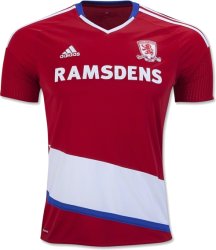 |
AWAY JERSEY
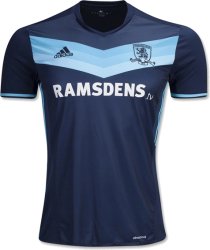 |
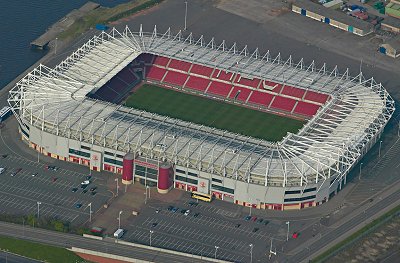
Click On Aerial Photo To View/Download Enlarged Image
|
Riverside Stadium (Middlesbrough) Seating Diagram
Click On Diagram Below To Enlarge View
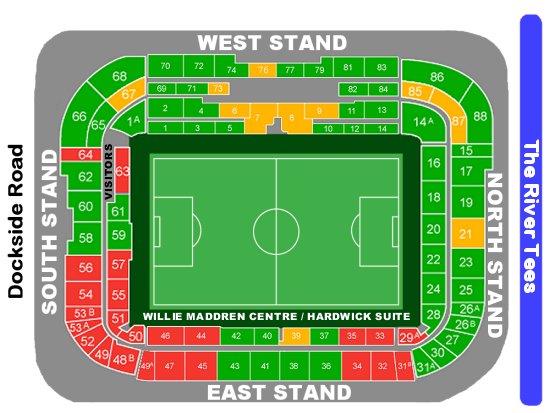
|



MIDDLESBROUGH STADIUM WALLPAPERS (Free Download)
Wallpaper Size below is 800x600: To Download Bigger Sizes, Click On Any Button Shown Above
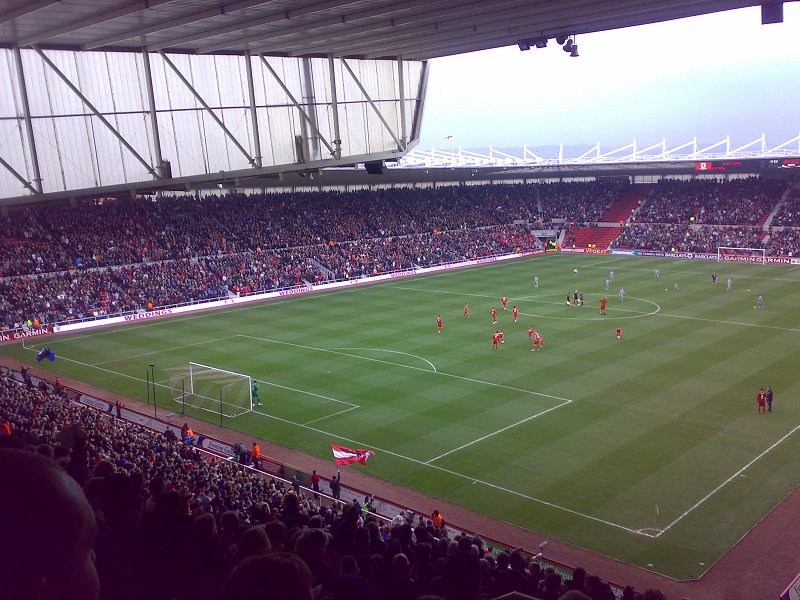
|
|

